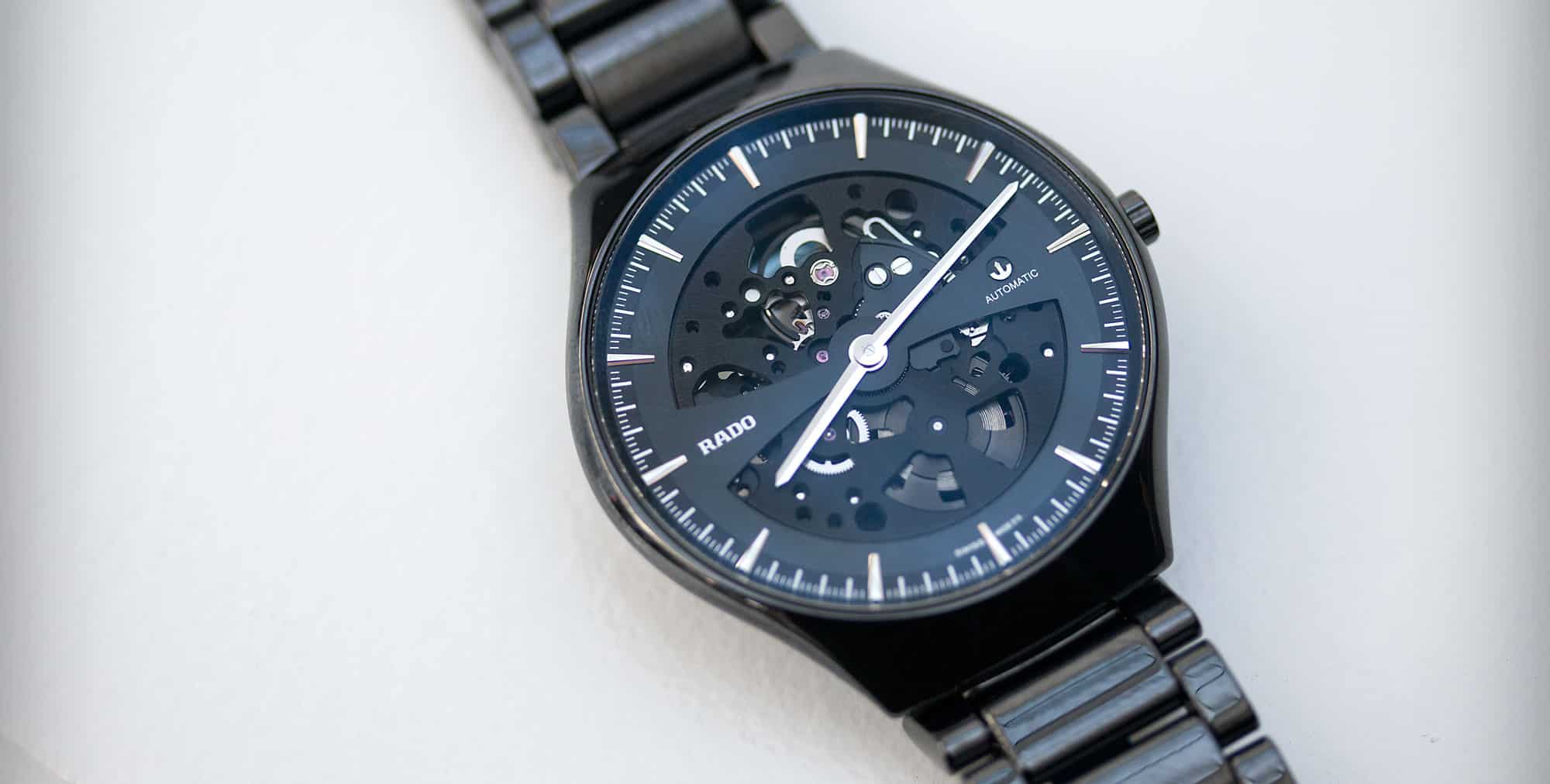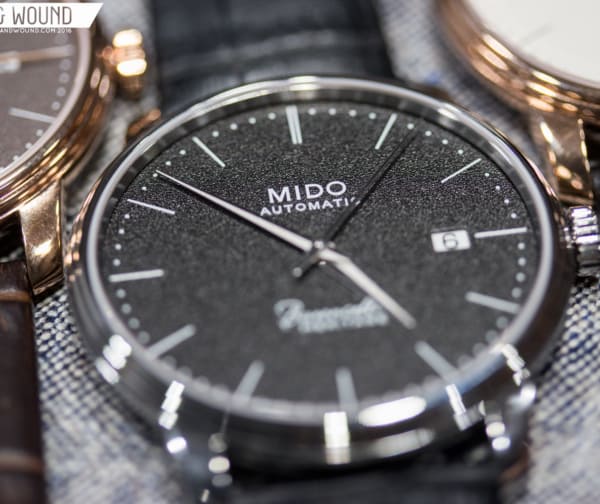2016 has only just begun, but the Basel previews are already teeing up. First up: Rado. One of Swatch Groups brands, Rado focuses on ceramic technology and a distinctly modern aesthetic, setting it apart from its sister brands, such as Longines and Tissot. Their Basel teaser was pleasantly surprising, with a small selection of sexy watches that were thoroughly Rado in style. The theme, for the most part, was thin and skeletonized, two concepts that work well for the brand. But, within those concepts, they had some unexpected design features that I’ve simply never seen on a watch, which isn’t something I get to say very often.
Thin is in
The first watches I took a look at were the “True Thinline” series in quartz and mechanical. Both feature incredibly thin cases at 4.9 and 7mm, respectively. The 4.9mm case is actually the thinnest and lightest watch Rado has ever produced. A quick glance at the case reveals that the construction is atypical as they feature monobloc ceramic cases with flowing, ergonomic lines. Because of the construction, which takes some sort of injected ceramic to create, there is no metal core (typically ceramic is around a skeleton armature of steel or titanium). This allows for a reduction of thickness, as well as sculptural lines. When paired with a ceramic link bracelet, the result looks and feels unlike anything else.
The quartz series are 39mm and come in white, black and plasma, which is a dark chrome-like color. They feature a super thin, 1mm ETA quartz movement, and extremely minimal designs. The dials match the case colors, having just hour and minute hands and a Rado logo at 12. They are stark and striking, particularly in the Plasma coloration, which is gorgeous in person. While these might not be for everyone as they are quartz, monotone and super minimal, I really enjoyed seeing the brand do something so restrained. These would make great dress watches for someone with a more sleek, modern aesthetic.
The mechanical version, or True Thinline Skeleton, is 40mm and features a skeletonized, PVD ETA 2892. Unlike its quartz sibling, the Skeleton has a more typical dial featuring an index around its edge, giving it a sportier feel. I was glad to see they made a mechanical version, as the case design and concept are fantastic, and utilizing them to create a 7mm automatic makes complete sense. On the wrist, the watch is incredibly comfortable. That said, the Skeleton is a very limited edition of only 99 pieces, and has a price tag nearing $5k, so these are unlikely to grace our wrists anytime soon.
The dial is made of what?!
Next up was the True Open Heart series, a pair of automatic watches in white and black. Sharing the monobloc construction, these watches are a bit thicker at 10.4mm as they feature 80-hr ETA C07.631 movements, which are based on the 2824. As the name indicates, these are open heart watches, but not in the typical fashion. Rather than an aperture through the dial, the semi-skeletonized movement is visible through a ghostly surface material…what’s amazing is that the material is a .6mm thin wafer of mother of pearl. To be completely blunt, I have never liked anything made of MOP in my life. I find it tacky, and don’t understand why it would be used on anything intended for men. So imagine my surprise when I found these to be very cool.
As Matthias Breschan, CEO of Rado, explained to me, MOP is typically painted on its back to give it opacity, which brings out the swirling, opalescent silvers, pinks and greens that make it such a distinctive material. Since Rado didn’t paint it, and used a very thin slice, what you have is a strange organic film with subtle swirls that allow a view through to the movement, but obscure it just enough to create something almost mysterious. Certainly an unexpected use of the material. These are limited to 500/color.
Taking it to the edge
Next up sticks with the open heart theme, but goes steel for the cases. Staying pleasantly small at 38 x 42 x 10.1mm, the Centrix Open Heart watches take a bit from the Trueline skeleton dial and the True Open Hearts, sharing the index of the former and the 80-hr movement of the latter. The aesthetic is once again fairly modern, though taking away the swooping ceramic, and using applied markers does give it a bit more of a retro feel. That said, the geometric dial cutaways speak to Rado’s contemporary leanings. With a starting price just north of $1,000 on leather, these were created to be a more affordable option, comparing to Hamilton and Tissot mechanicals.
What struck me about these watches is actually something you might not notice at first. The sapphire crystal runs edge-to-edge and there is no bezel. What might appear as one, a chrome ring, is actually underneath. This gives the watch a very clean look as well as functionally creates a very scratch resistant top surface, as Sapphire is much harder than typical 316L steel as well as most hardened steels. The crystal is actually attached with special adhesive that Rado developed. While on a sport watch a mechanical attachment might seem more secure, for a dressy watch like this, and adhesive makes sense. Regardless, the result is very cool.
Getting Drozy
Last, but far from least, was the DiaMaster Grande Seconde series. A variation on something we saw at Basel last year, in terms of my tastes, these were the show winner. Larger than the rest at 43mm, the DiaMaster utilizes Rado’s Plasma ceramic as well as a monobloc construction, bringing the mid-case right up the to sapphire. Unlike the True line though, they went for a more classic shape, and needed some additional size for the asymetrical dial and off-center movement. A quick glance at the case back shows off the unique placement of the ETA 2899 movement within (see in gallery).
More striking than the case is the dial. With a massive seconds sub-dial at nine and off-center hour and minute dial, the shifted layout creates a very dynamic and eye catching design. Around the sub-dials is “clous de Paris” graining, adding some texture to the negative space. It immediately brings to mind another Swatch group property, Jaquet Droz, who are known for there “Grande Seconde” watches as well. Of course, those are high-end luxury pieces that are priced for a different customer. At $3,000 MSRP the DiaMaster Grande Seconde are more accessible, albeit still pricey. Regardless, they are genuinely very attractive and while a bit large (though the same diameter as the JD’s), great looking on the wrist.
That’s it for the teaser, now we’ll have to wait until March to see their full Basel offering.









 Featured Videos
Featured Videos












